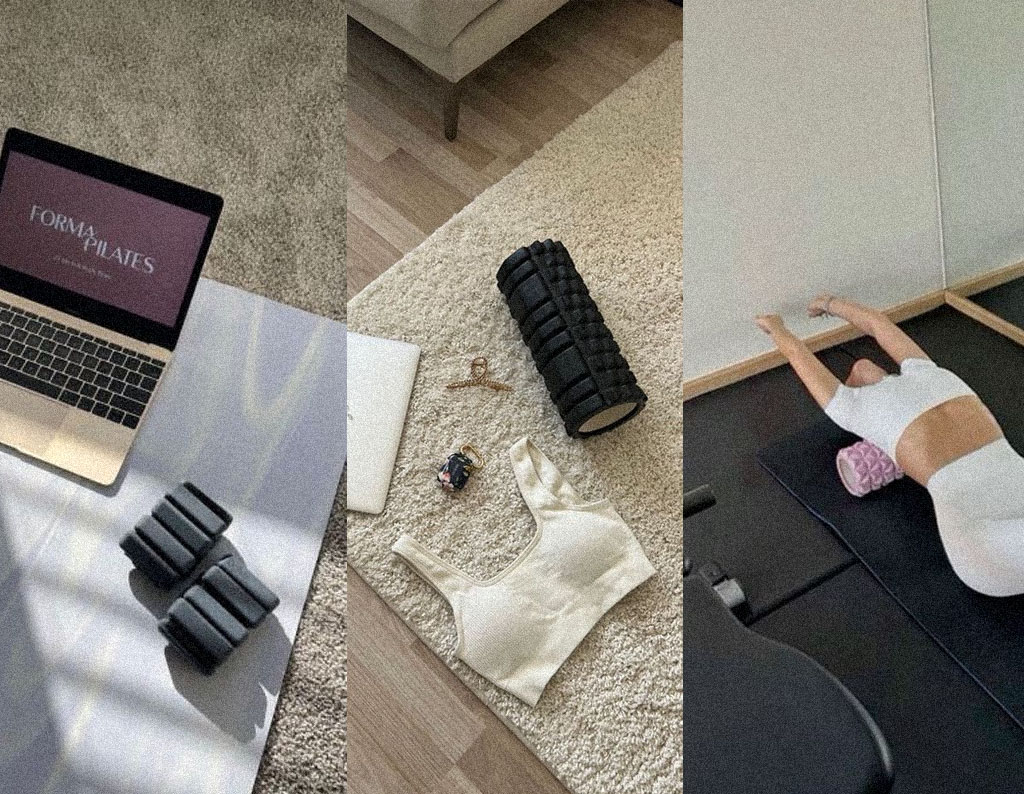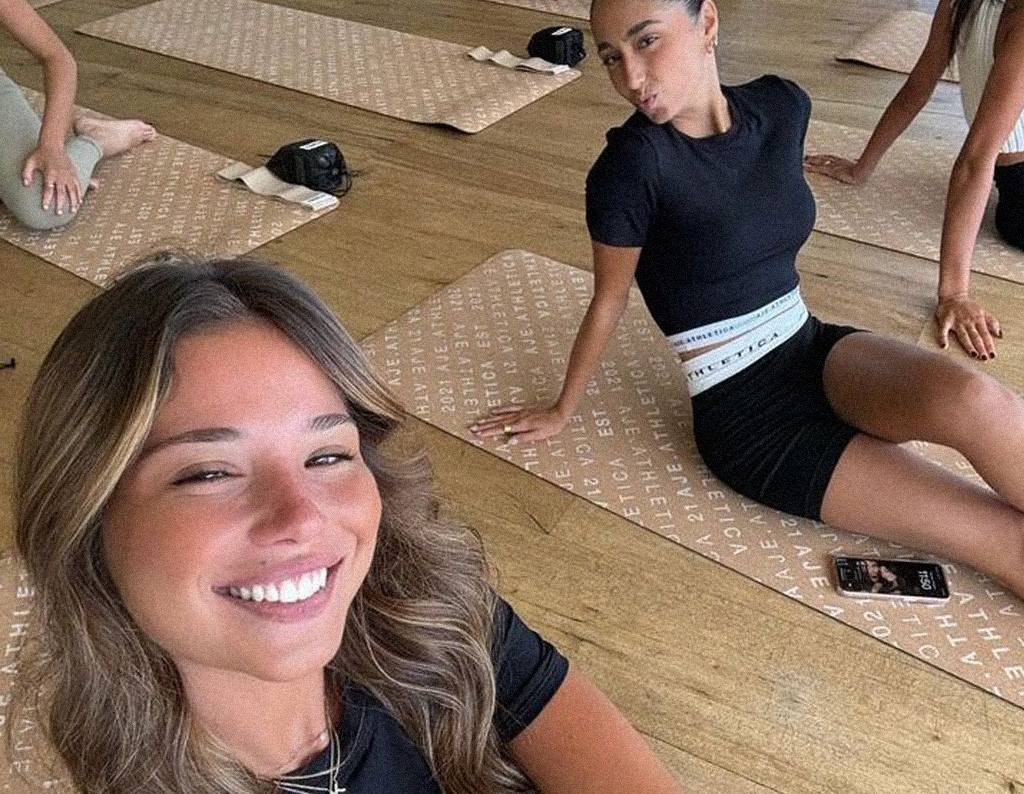Wall Pilates: The New “It” Workout For Busy Women?
If you’ve been scrolling through TikTok or have even a passing interest in the latest fitness trends on social media, you’ve probably noticed the buzz around wall Pilates. We at the Daily Rituals HQ were intrigued by video after video of stunning body transformations, all thanks to a regular wall Pilates routine. Naturally, we had to do a deep dive (for journalistic purposes, of course) and tried out a few exercises ourselves.

Now, much like other viral workout trends (think 75 hard, soft hiking or the “12-3-30” workout), wall Pilates has taken the internet by storm. Doing wall Pilates regularly supposedly enhances your tone, balance, and mental clarity without needing much equipment (thanks to the handy addition of the wall), making it perfect for an effective workout in the comfort of your own home. Here, we’ll give you the real, unfiltered DL on whether you should (or shouldn’t) try a session soon.
So… Where Did Wall Pilates Come From?
As of 2023, over 12 million people (many of whom fill our Instagram feeds..), have embraced the Pilates lifestyle. It all started with the legendary athlete and circus performer Joseph Pilates in Germany back in 1914.
With a gymnast father and a naturopath mother, it’s no wonder he developed a holistic approach to fitness, laying the foundation of a multi-million pound industry.
Fun fact: the concept for the self-titled Pilates workout came to Joseph during World War I, while he was imprisoned on the Isle of Man. He worked out with fellow inmates, developing exercises to strengthen both mind and body—what we now know as Pilates.
Although wall Pilates isn’t part of Joseph’s original repertoire (and arguably, he might not entirely approve given his classical approach), it emerged during the pandemic as a creative solution for staying fit at home. People were literally climbing the walls looking for new ways to exercise, and voilà—wall Pilates was born.
What is Wall Pilates?
Hot girls prioritise their fitness, but they also know how to budget their precious time and money. Whilst we adore a good Reformer session, a one-on-one session in London costs upwards of £75, and group classes are usually around £30 per class. So if you’re going the recommended 3-4 times a week, it starts to add up.
Wall Pilates won’t replace your favourite Reformer pilates class, but it’s a great addition to your at-home routine. At its core (see what we did there?), it involves performing usual Pilates exercises with the added support of a wall. Initially, it might seem a bit odd, but the wall offers resistance similar to a Reformer foot bar, enhancing control, flow, and precision.
The beauty of wall pilates is that all you need is a bare wall (ideally with some grip socks on) to add it into your workout routine. So whether you’re mid zoom at your desk (camera off!) or have a quick 20 minute break, it’s a great way to add some extra dimension to your at-home pilates practice. Plus, it can burn up to 427 calories in one intense 45-minute session.
Wall Pilates: The Benefits
A Wall Pilates workout takes the principles of traditional Pilates and adds the support of a wall for added difficulty and dimension. Wall pilates is great for:
Reviewing Wall Pilates: Is it a Yay or Nay?
Naturally, the Daily Rituals team had to give it a go, so we all went on our individual wall Pilates journeys at the start of summer. For context, we’re seasoned Pilates girlies. We mix Reformer, mat, and resistance training into our weekly routines. Here’s our unfiltered DL on how we found it, and whether we’re still doing it..

What We Loved
First up, we loved that it fitted so easily into our hectic schedules, since you just need a 20 minute break & a clear wall at home to get going. One of the team said she loved learning how to level up certain moves with a wall, and now that she’s learned the key wall moves, she adds these into her at-home mat class for some extra spice.
We’ve found that it’s also a great one for post-natal fitness, thanks to the support provided by the wall. For new mums who are still easing themselves back into fitness, it’s a safe and effective way to re-strengthen core muscles & support your lower back. Make sure to follow a post-natal programme though, to be sure you’re not overdoing it.
Finding a good class wasn’t super easy, especially if you’re used to a serious pilates flow. Our favourites were:
- Rachel’s Fit Pilates 28-Day Wall Pilates Challenge
- Jenna Collins Fitness 28-Minute Wall Pilates Workout
- Raminara’s Full Body Wall Pilates Workout
Overall, we felt that it wasn’t as challenging as other strength exercises or some at home mat classes (especially with added equipment), so if you’re a seasoned Pilates girl – you’ll want to opt for wall pilates on the days you just want to flow without stressing your body too much.
Things to Consider
While wall Pilates has many benefits, it’s not without its considerations. Doing it at home on your yoga mat means you miss out on having a certified pilates instructor to correct your form and posture. Even though we absolutely felt the burn from our wall Pilates workouts, there aren’t as many at-home classes to follow, so most of us reverted back to our go-to home subscriptions (Team favourites being Forma Pilates Online & The Pilates Class) and added in some extra wall moves as we went.
If you’re new to pilates, wall Pilates is perfect for easing you into it until you’re ready for more intense workouts. We also recommend eventually adding in equipment like resistance bands and our go-to Bala ankle weights as you progress. Plus, even though some routines suggest it – try avoiding using the wall unnecessarily if it doesn’t feel like it’s adding anything to the move e.g. for upper body strength, a body weight push up is probably better performed on your knees than on the wall if you’re working up to a full rep.
Does Wall Pilates Work? Here’s What We Honestly Think About The “Pilates Wall Workout”
As girlies who do Pilates regularly, we initially hesitated to try this workout trend. The idea of putting our feet up on our clean walls (or accidentally putting a foot through them!) seemed strange. But, with grip socks on, we managed to avoid ruining any walls as well as finding a new way to add some variety into our pilates flows. Generally, as you can probably tell, we feel that you don’t need to use a wall for everything in Pilates since much of the strength comes from holding your legs up & keeping your core engaged. However, the wall can provide excellent support for new moves and extra resistance for lower body exercises like bridges.
For those who prefer a balanced approach, a fusion of mat, wall & reformer Pilates would be ideal, alongside some strength training sessions and low-intensity cardio like walking. That way, you avoid muscle imbalances from repeating one kind of workout, plus you’ll see the best overall full body results. Not everything needs to be in studio, there’s plenty of great trainers to follow for your home workouts.
So, yes, wall Pilates is a yay for us, but we’re going to continue to mix it in with our usual routine, rather than switch anything out to focus entirely on wall pilates.






